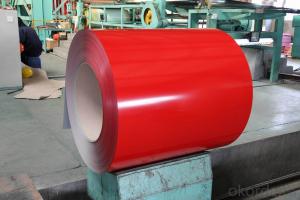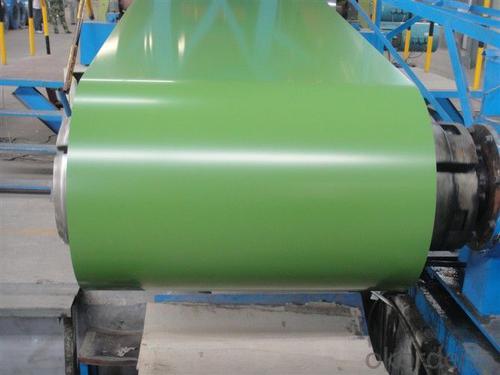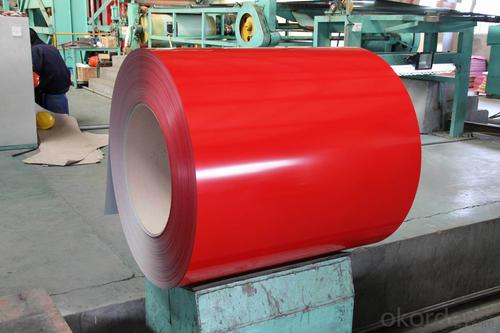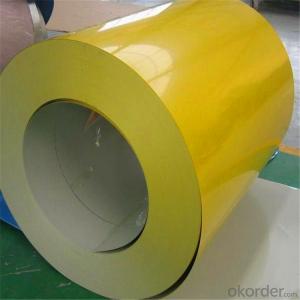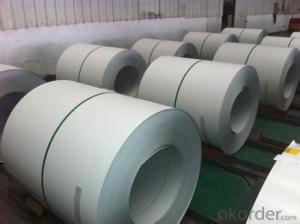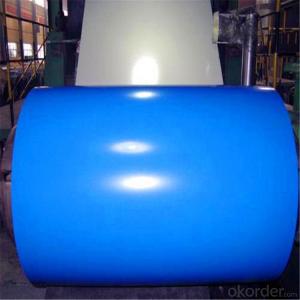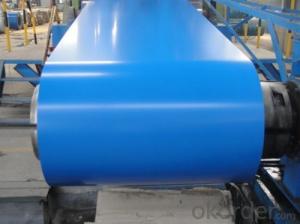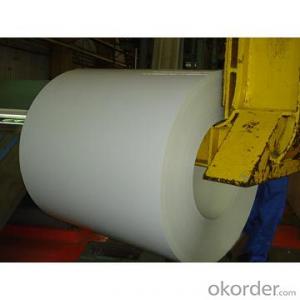Prime Quality Prepainted Galvanized Steel Coil
- Loading Port:
- China Main Port
- Payment Terms:
- TT OR LC
- Min Order Qty:
- -
- Supply Capability:
- -
OKorder Service Pledge
OKorder Financial Service
You Might Also Like
1) AVAILABLEDESIGNATION OF (Prepainted galvanized steel coils) printed PPGI coils
Quality Q/BQB440-2003 JIS G3312-1994 EN 10326-2004 ASTM A653-02a
EN 10327-2004(BASE PLATE)
(BASEPLATE)
Commercial SteelTDC51D CGCC DX51D+Z/AZ CS Type A/B/C
Forming Steel(TSt01,TSt02,TSt03) CGCD1 FS Type A, Type B
Drawing TDC52D/TDC53D - DX52D+Z/AZ DDS TYPE A/C
Steel DX53D+Z/AZ
StructuralTS280GD(TStE28) CGC400 S280D+Z/AZ SS275
SteelTS350GD(TStE34) CGC440 S350D+Z/AZ SS340 Class1
2) OURSPECIFICATION OF (Prepainted galvanized steel coils) printed PPGI coils
Available Size:
ManufacturerThickness Width Length of plate Inner diameter of coil
JIANGSU HUIYESTEEL SHEET CO.,LTD 0.2-1.2mm 800/914/1000/1200/1219/1250mm 1000-6000mm508mm/610mm
Coated Mass OF(Prepainted galvanized steel coils) printed PPGI coils:
Base plateAvailable Coated Mass(g/m^2)
Galvanized Steel80, 100, 120, 160, 180
Galvalume Steel50, 70, 150
AvailablePainting OF (Prepainted galvanized steel coils) printed PPGI coils:
Category ofPainting Item Code
Polyester PE
High-durabilitypolyester HDP
Silicon modifiedpolyesters SMP
Polyvinylidenefluoride PVDF
Easy-Cleaning —
PaintingThickness Top side: 20+5microns;
Bottom side:5~7microns.
Color SystemProduce according to RAL Color System or as per buyer’s color sample.
Paintingstructure Top surface Bottom surface
Primer coatingNo coating 1/0
Primer coatingPrimer coating 1/1
Primer coating +Finish coating No coating 2/0
Primer coating +Finish coating Primer coating or single back coating 2/1
Primer coating + Finish coating Primer coating + Finish back coating 2/2- Q: What is the width range of steel coils?
- The width range of steel coils can vary depending on the specific requirements, but it typically ranges from a few millimeters to several meters.
- Q: i'm looking into buying a stainless steel ring for somebody as a gift.i'm on a budget (heh) and the ring is about $50.will it rust or tarnish? it'd be embarrassing if i gave it to someone, and it begins rusting :Pthanks
- Stainless steel is a generic term for a huge variety of different alloys. In manufacturing, each steel has different numbers, etc that they go by. Some steel sold as being stainless actually is not. It rusts, like the cheap kitchen knives you see that are left in the sink too long. However, the stainless in jewelry is pretty legit. Overpriced, but legit. It will not tarnish, but it won't stay shiny forever. It might get a little less glossy over time. When it does get re-polished, it takes a long time to do it. But it will not turn black or rust. Good luck.
- Q: How many pounds can steel lift?
- I think that you failed to put up a meaningful question. I suggest that you try again and seek help.
- Q: How are steel coils made?
- Steel coils are made through a process called hot rolling, where steel slabs are heated and passed through a series of rollers to reduce their thickness and shape them into long, coiled strips. This process helps enhance the steel's strength and flexibility, making it suitable for various industrial applications.
- Q: I'm doing a project on stainless steel dining utensils and its a little more difficult than i thought it would be. There are no sites on the web that tells the creator or when it was first used. There's no sites that that i can see of that talk about the history of stainless steel dining utensils, only dining utensils in general. Please help, i can't change my project now ):
- The development of 18/10 stainless steel was the brainchild of Harry Brearley who, in 1913, was working on a project to prevent rifle barrels from corroding so much during use. His analysis of the rifle barrels involved having to dissolve them in acid but, by chance, he noticed that steel which had a high chromium content did not dissolve in the acid. He experimented with varying proportions of chromium and finally produced a stainless steel with 12.8% chromium. He moved to Thos Firth Sons in 1914 and commercial production of stainless steel cutlery began. Refinements were necessary because early versions of stainless steel knives were harder to produce and polish, and they would not cut as well as the existing knives.
- Q: How are steel coils used in the production of steel springs?
- Steel coils are used in the production of steel springs by being cut and shaped into the desired size and shape of the spring. The coils are then heated and tempered to improve their strength and flexibility. The steel coils provide the raw material necessary for creating durable and reliable steel springs used in various applications such as automotive, furniture, and industrial machinery.
- Q: my friend needs sensitive ears....she wants to borrow mine but it says surgical steel,what does that mean?
- Surgical Earrings
- Q: it seems like the hardness of Stainless steel, i saw 410c stainless stell, i saw 440c stainless steel, what does it means anyway?
- 440 okorder
- Q: But we've had a problem with bears being attracted to the water in the Intex Inflatable pools, the bear would come at night every so often and push on the sides letting out the water.Would a bear be able to bend a steel frame before I go and spend money?
- depends how thick the steel is. Looking at it, I would say yes. Not the frame pieces, but just the walls of the pool.
- Q: Can steel coils be coated with aluminum?
- Yes, steel coils can be coated with aluminum. This process is commonly known as the coil coating or the prepainting process, where a layer of aluminum is applied onto the steel coils to enhance their corrosion resistance and improve their aesthetic appearance.
Send your message to us
Prime Quality Prepainted Galvanized Steel Coil
- Loading Port:
- China Main Port
- Payment Terms:
- TT OR LC
- Min Order Qty:
- -
- Supply Capability:
- -
OKorder Service Pledge
OKorder Financial Service
Similar products
Hot products
Hot Searches
Related keywords

